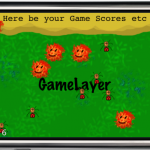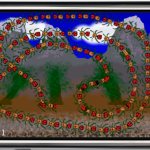To put it in Apple’s words: “Taking Cocos2D to a whole new level.” I can’t brag with 200+ new features though I have a few in store that should make a big bang for no bucks! 😀
So, here speaketh the market crier for Kobold2D. What’s new and noteworthy about this version of Kobold2D, you ask?
Built-In Gesture Recognition
Recognizing gestures has never been this easy. No (speak: zero) iOS SDK knowledge required! All gesture recognizers provided by the iOS SDK are implemented:
Tap, Double-Tap, Long-Press, Swipe, Pan, Rotation and Pinch.
AccSim written by Otto Chrons is an App (download on iTunes) that allows you to control your game running in the Simulator with your iOS device. Meaning, the game plays in the Simulator but accelerometer input is actually coming from your device! You can learn more about it on the Built.By.Me website, which includes a sample video:
Hmmm … somehow this game seems strangely familiar. 😀
AccSim doesn’t pack the same punch as iSimulate does, which can also be used for sending multi-touch input, GPS and Compass events to the Simulator, plus a lot more. But the good thing about AccSim is that it’s not just free but the AccSim source code is open source!
Chapter 6 - Spritesheets and Zwoptex
In this chapter the focus will be on Spritesheets (Texture Atlas), what they are and when, where and why to use them. Of course a chapter about Spritesheets wouldn’t be complete without introducing the Zwoptex tool. The graphics added in this chapter will then be used for the game created in the following chapter.
The chapter will be submitted on Friday, August 6th.
Anything about Spritesheets you always wanted to know?
Just let me know. I’ll be researching what kind of issues people were and are having regarding Spritesheets. I want to make sure that they are all covered in the book.
Please leave a comment or write me an email.
Summary of working on Chapter 5 - Game Building Blocks
 I finally found a better title for the chapter. A big part is about working with Scenes and Layers. A LoadingScene class is implemented to avoid the memory overlap when transitioning between two scenes. Layers are used to modify the game objects seperately from the static UI. I explain how to use targeted touch handlers to handle touch input for each individual layer, either swallowing touches or not.
I finally found a better title for the chapter. A big part is about working with Scenes and Layers. A LoadingScene class is implemented to avoid the memory overlap when transitioning between two scenes. Layers are used to modify the game objects seperately from the static UI. I explain how to use targeted touch handlers to handle touch input for each individual layer, either swallowing touches or not.
The issue of whether to subclass CCSprite or not is discussed and an example is given how to create game objects using composition and without subclassing from CCNode and how that changes touch input and scheduling.
At the end the remaining specialized CCNode classes such as CCProgressTimer, CCParallaxNode and the CCRibbon class with the CCMotionStreak are given a treatment.

As you can see from the pictures, I’m also making good progress at becoming a great pixel artist. Only I have a looooooong way ahead of me still. But I admit, the little I know about art and how much less I’ve practiced it, I’m pretty happy about the results and having fun with it. The cool aspect of it is that this should be instructive art. It doesn’t have to be good. So I just go ahead and do it and tend to be positively surprised by the results. I’ll probably touch this subject in the next chapter about Spritesheets: doing your own art. It’s better than nothing, it’s still creative work even if it may be ugly to others, and it’s a lot more satisfying to do everything yourself, even if it takes a bit longer and doesn’t look as good. At least it’s all yours, you’re having fun, and learn something along the way. And you can always find an artist sometime later who will just draw over your existing images or who replaces your fart sound effects with something more appropriate.
Btw, if you’re looking for a decent and free image editing program for the Mac, I’ve been using Seashore for about a year now and I’m pretty happy with it.












